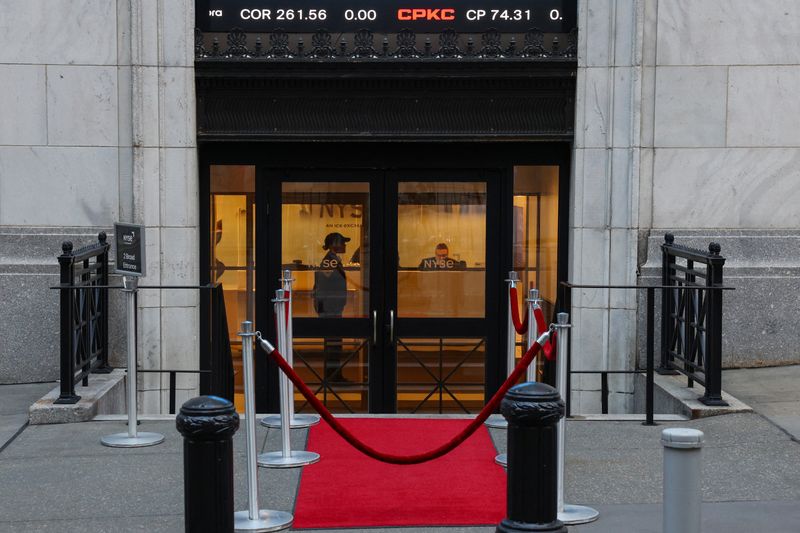By Lewis Krauskopf and Suzanne McGee
NEW YORK (Reuters) – Investors are wary about worrisome market signs, after a steep U.S. stocks selloff that has wiped out more than $4 trillion in value and all of the gains notched following President Donald Trump’s election.
Among the signs are technical signals such as the S&P 500 on Monday closing below a crucial trend line, a key measure of the market’s internals weakening, a concerning pattern in volatility futures contracts, rising cash levels among investors and de-leveraging by hedge funds away from equities.
U.S. equities experienced a punishing drop this week, with the S&P 500 briefly falling into correction territory on Tuesday as uncertainty over Trump’s tariffs exacerbated worries about economic growth.
“This is a classic S&P 500 selloff, with growth stocks taking it in the teeth,” said Patrick Fruzzetti, managing director of Rose Advisors, part of wealth management firm Hightower Advisors. “With more bearish signals appearing, this could be ongoing for quite a while.”
After registering its biggest drop of the year on Monday, the benchmark S&P 500 index endured another volatile day on Tuesday, ending down 0.8%. The index has dropped 9.3% from its February 19 record high, with some of the market’s highest fliers including Nvidia and Tesla hit particularly hard. It is now down 3.6% since Trump’s November election.
TARIFF, RECESSION UNCERTAINTY
The ominous market signals add to growing anxiety about the economic outlook. A Reuters poll last week found 95% of economists across Canada, the U.S. and Mexico said the risk of a recession in their respective countries had increased following Trump’s chaotic tariff implementation.
Trump has offered conflicting views on whether the U.S. could face a recession amid tariff concerns. Over the weekend he declined to predict if there could be a recession. On Tuesday Trump’s take on a possible recession was: “I don’t see it at all.”
“The back and forth on tariff announcements is playing havoc with consumer and business confidence,” equity strategists at HSBC said in a note.
Shares of major U.S. airlines sank on Tuesday after Delta Air Lines slashed its first-quarter profit estimates by half. Delta’s CEO said the environment had weakened due to U.S. economic uncertainty.
WORRYING TECHNICAL SIGNALS
On Monday, the S&P 500 closed below its 200-day moving average — a closely watched long-term trendline — for the first time since late 2023.
Bespoke Investment Group found that in 15 other instances when the S&P 500 stayed above its 200-day moving average for at least a year, when the index finally fell below the trendline, returns over the next year were generally weaker than normal. The S&P 500 rose 6.9% on a median basis in those cases compared with a 10.3% one-year median gain historically.
“We are starting to shift more toward a downtrend,” said Adam Turnquist, chief technical strategist for LPL Financial. “That alone is a warning sign.”
Turnquist also noted a key measure of the market’s internals was weakening. The number of S&P 500 constituents above their 200-day levels had dropped to 47% as of Monday. When that percentage has dropped below 48% historically, the S&P 500 has fallen by an average of 7.3% over the next year, according to Turnquist, citing data since 1990.
The yield spread between junk-rated corporate bonds and U.S. Treasuries — typically a measure of investor views of the strength of the riskier part of the corporate sector — widened to 316 basis points on Monday, the biggest spread since September.
The widening spread is “showing that the markets are getting more concerned with this growth slowdown narrative,” said Matthew Miskin, co-chief investment strategist at John Hancock Investment Management.
Philip Palumbo, founder and CEO of Palumbo Wealth Management, said some clients who had a full allocation toward stocks were lightening up on equity exposure because of concerns about elevated valuations.
Even with the recent slide, the S&P 500 on Monday was trading at 20.5 times earnings estimates for the next year, versus a long-term average P/E of 15.8, according to LSEG Datastream.
“Volatility, with valuations at all-time highs, has made stocks too unpredictable,” Palumbo said.
NO MORE BUYING DIPS?
Absent a signal that either confirms or denies economic fears, the market could be entering a period when sharp rallies get sold, provided investors keep rotating out of equities into bonds and from U.S. equities into markets abroad, Nomura strategist Charlie McElligott said in a note on Tuesday.
Equity volatility futures contracts expiring this month are trading at a premium to those expiring eight months out, signaling greater investor concern about higher volatility now than future market turmoil.
Volatility futures have been in this state, called “backwardation,” for four straight sessions, and history suggests it may take a few more days before investors grow less fearful. Over the last 10 years, volatility futures, once in backwardation, remain in a state of heightened fear for up to seven sessions on average, according to a Reuters analysis of LSEG data.
To be sure, the pullback in stocks could become an opportunity for investors. “Buying the dip” has often been a profitable strategy over the past 15 years, with the S&P 500 up over 700% since the market bottomed during the financial crisis in March 2009.
Concerns about a severe economic growth scare were overblown, said Scott Wren, senior global market strategist at the Wells Fargo Investment Institute. The firm on Tuesday recommended clients move some of their allocation in fixed income to equities, specifically mid-cap stocks, Wren said.
“The stock market’s probably going to trade a little bit lower before we see some sort of a meaningful rebound,” Wren said. “But we’re trying to stick a toe in and do a little buying.”
(Reporting by Lewis Krauskopf; additional reporting by Saqib Iqbal Ahmed, Carolina Mandl and Davide Barbuscia; editing by Megan Davies and Leslie Adler)


